Sunday – Home – All Fools’ Day, but no fooling with the weather which is bright and sunny again. Kay is slowly clearing the last piece of rough ground at the bottom of the garden. It is very hard work with enormous old Ivy roots coming out along with nettles and brambles. We are leaving a pile of old branches along the back wall to provide shelter for any wildlife. We will also ensure there will be plenty of insect-friendly plants replacing the Ivy. All of the new fruit trees are budding. A Blackcap is singing in the great old Horse Chestnut which towers above the summer house.
Monday – Mortimer Forest – Dawn saw the sun rise into a clear blue sky but now clouds are building from the north. Chiffchaffs call loud and clear. Deep in the woods a Song Thrush sings. It is still cold enough to nip my fingers. A Great Tit joins the 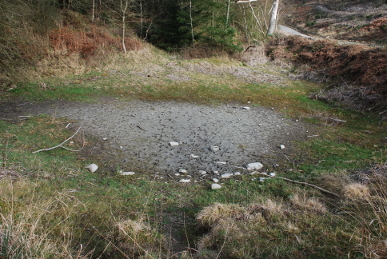 chorus. The tracks have been resurfaced with chippings. A Bumble Bee species rests on the ground. It has noticeably thin, black wings and an almost unmarked hairy brown body, but subsequent searching for an identification fails. Violets and Wood Spurges are in flower on the banks beside the track. The pond is dry – not a good sign as winter rains would normally have filled it. Deer hoof prints mark the soft mud. Up through the conifer plantation on the usually muddy path but it has almost dried out. Clumps of Primroses shine in the dark edges of the woods. The air is
chorus. The tracks have been resurfaced with chippings. A Bumble Bee species rests on the ground. It has noticeably thin, black wings and an almost unmarked hairy brown body, but subsequent searching for an identification fails. Violets and Wood Spurges are in flower on the banks beside the track. The pond is dry – not a good sign as winter rains would normally have filled it. Deer hoof prints mark the soft mud. Up through the conifer plantation on the usually muddy path but it has almost dried out. Clumps of Primroses shine in the dark edges of the woods. The air is 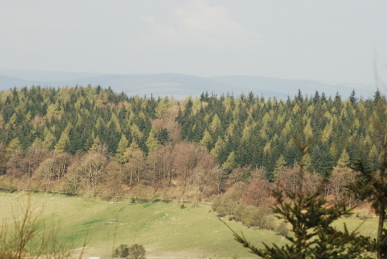 full of buzzing as bees visit Hazel catkins. The catkins are clearly not sufficiently opened as the bees soon depart leaving the sound of a Chiffchaff, drumming woodpecker, singing Song Thrush and cooing Wood Pigeons. A Yellowhammer perches atop one of the tall Larches halfway up the hillside. The morning is warming and I remove my jumper whilst sitting beneath the Larches on a fallen log. Above Linnets, Blue and Coal Tits tumble in the trees. A pheasant croaks in the distance. Off up the path towards High Vinnalls, past Climbing Jack Common. A Willow Tit calls briefly. From the summit, the distant hills are misty, the fields below verdant. A Raven circles overhead for a few moments, cronking gutturally, before gliding off towards Bringewood. The conifers there are a beautiful patchwork of lime and dark greens. A Chaffinch sings on the slope below. The common rings to the songs of Skylarks. Meadow Pipits search the grass.
full of buzzing as bees visit Hazel catkins. The catkins are clearly not sufficiently opened as the bees soon depart leaving the sound of a Chiffchaff, drumming woodpecker, singing Song Thrush and cooing Wood Pigeons. A Yellowhammer perches atop one of the tall Larches halfway up the hillside. The morning is warming and I remove my jumper whilst sitting beneath the Larches on a fallen log. Above Linnets, Blue and Coal Tits tumble in the trees. A pheasant croaks in the distance. Off up the path towards High Vinnalls, past Climbing Jack Common. A Willow Tit calls briefly. From the summit, the distant hills are misty, the fields below verdant. A Raven circles overhead for a few moments, cronking gutturally, before gliding off towards Bringewood. The conifers there are a beautiful patchwork of lime and dark greens. A Chaffinch sings on the slope below. The common rings to the songs of Skylarks. Meadow Pipits search the grass.
Wednesday – Bodenham Lake – The air is sweetly scented although I am not sure of the source. The only blossoms I can see are Willows (Goat Willow also called Sallow, Grey and White Willows) and a glorious display of Blackthorn. Last night started out fairly clear but by this morning it has rained briefly. The rain turned to sleet then back to rain again. It stopped for a while but is falling again now. Dunnocks and Chiffchaffs lead the subdued avian chorus. A bee shelters under a down-facing poplar leaf. On the lake there are the usual noisy Canada Geese, Tufted Duck, Mallard, Teal, Coots and Mute Swans. All the Cormorants appear to have departed. Sand Martins sweep over the surface. Surprisingly, there are also several House Martins and Swallows here too. A pair of Goldeneye are still present. The first Hawthorn flowers have appeared in the hedge by the meadow. Blossom is dense on perry and dessert pears in the orchard. The rain has turned to sleet again.
Home – The rain continues through the day. Finally the water-butts refill, or at least two out of the three do so. The ground is soaked which is a real blessing. The broad beans are still quite short but do have an abundance of flowers; the later sown seedlings have hardly developed at all but hopefully now they will. It grows colder during the evening which is a worry in respect of the blossoming cherry, pears, apricot and peach, but the low temperature is mainly anticipated as wind-chill and the garden is well protected. However, the weather across the country has been far worse – snow drifts in the north-east down as far as Derbyshire; many hundreds of homes without power as the electricity lines come down and chaos on the road network. Pictures on the television shows the M62 at a standstill, but this is hardly anything unusual!
Good – Eaton Hill – The night brought an unwelcome heavy frost and the morning is chilly. The River Lugg flows steadily. Butterburs are flowering by the river near the Millennium Wood, although they do not look happy in this cold. The weather has not quietened the Chiffchaffs which are plentiful. Celandines and Cuckoo Flower are emerging beside the path. Up the Worcester Road and up towards the drovers’ steps. Ground Ivy and White Dead Nettle are flowering. Wrens and Blue Tits sing. At the top of hill Skylarks sing. 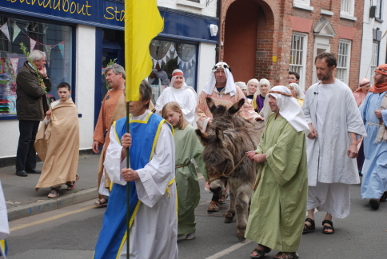 There is a large patch of pink flowers that I cannot place, they look like members of the Labiate family, but which one? Back down hill. Potatoes being planted in a field of immaculate furrows of rich red soil.
There is a large patch of pink flowers that I cannot place, they look like members of the Labiate family, but which one? Back down hill. Potatoes being planted in a field of immaculate furrows of rich red soil.
Leominster – The Passion Play is taking place this morning starting at the Forbury Chapel. It is staged once every four years and has attracted a large crowd. Unfortunately, we can see little and Maddy is at risk of being trodden on by the milling crowd. We move down Church Street and wait for the players to pass and then decide we will be better off inside The Grapes! Back home where an Early Grey moth, Xylocampa areola is on the front door post.
Easter Sunday – Nunney – A couple of days in Somerset. We arrive in time for the Easter Bonnet competition which Jemima 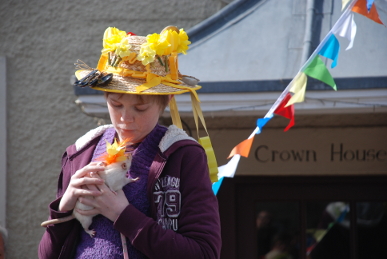 wins for the first time! She has been passed over, rather unfairly in my view, for a good number of years now. She enters her rat into the animal Easter bonnet section and is clearly the best one but is not chosen – I suppose two prizes is too much to expect! The duck race is a pretty boring affair as the Nunney Brook is running very sluggishly. The sluice gates of the mill pond are supposed to have been opened to create a flow but this does not seem to be successful. Eventually, a few of the yellow ducks escape the confines of twigs blocking the edge of the stream and make their way to the finishing line where they come to halt a few feet short. Boredom takes over and they are scooped up and a winner declared. We wander off to have a fine dinner of lamb raised by the Gibson-Wyers.
wins for the first time! She has been passed over, rather unfairly in my view, for a good number of years now. She enters her rat into the animal Easter bonnet section and is clearly the best one but is not chosen – I suppose two prizes is too much to expect! The duck race is a pretty boring affair as the Nunney Brook is running very sluggishly. The sluice gates of the mill pond are supposed to have been opened to create a flow but this does not seem to be successful. Eventually, a few of the yellow ducks escape the confines of twigs blocking the edge of the stream and make their way to the finishing line where they come to halt a few feet short. Boredom takes over and they are scooped up and a winner declared. We wander off to have a fine dinner of lamb raised by the Gibson-Wyers.
Bank Holiday Monday – Nunney – The weather is not kind and it is now raining. Up to the Rack field with the dogs. Zebedee puts up a brace of partridge, too far away to identify which species. A lone Swallow passes over the village. Plans to go to Mells for the Daffodil Fair are washed away, no-one is enthusiastic about wandering around in the wet. We drop into the George for a couple of pints. It is an old coaching inn – Hutton makes mention of it in “Highways and Byways of Somerset” commentating on the sign “which swings across the road” and still does. It serves a decent pint but is a gastro-pub, very comfortable I am sure but not my type of beer-house.
Wednesday – Bodenham Lakes – True April weather, very changeable. The lakes are much less populated compared to winter. A few non-breeding Cormorants occupy the raft. Canada Geese cackle under the trees on the island whilst more argue on the water. A few pairs of Mallard and Teal move around the edge of the lake. There is something laying on the gravel of the spit near the reed bed. At first I think it may be an Adder sunning itself, but I can see flies landing on it. In the end I decide it is probably a dead eel. Common Buzzards soar high overhead. All the hedgerows are getting greener by the day whilst the willow catkins now fade to grey fluff.
Thursday – Hereford – Off to the city to help with the Herefordshire and Worcestershire Earth Heritage Trust Road Show. The fields south of Leominster are bright green with new growth and have attracted good numbers of Carrion Crows, gulls, Wood Pigeons and several pairs of Mallard. People who know me and my long-standing intolerance of juveniles would be amazed to learn that I spend the day helping young children make plaster casts of fossils! Really good fun actually! There is a steady stream of children and their parents until shortly after two o’clock when the heavens open and down comes large balls of hail. Thunder and lightning rend the sky which is an amazing vision of greys and whites all churned and angry. Weirdly, in some places there is blue sky and shining brass edged white clouds. Despite the torrent of hail, a small flock of Lesser Black-backed Gulls glide over as if it is a calm and sunny afternoon. Back home on the train and the skies in the west again build up into great dark mountains of cloud with curtains of rain lashing down beneath them. Luckily I get home just before it hits us.
Saturday – Home – It is a fairly bright afternoon although plenty of cloud rolls across the sky. Time to sow more seeds. Three varieties of leek – Bandit, Early Market and Elefant – go into trays in the greenhouse. They will be planted on into troughs before following the potatoes into the bed. A tray of cabbage, Offenham also goes into the greenhouse. Spring onions – Crimson Forest and Lisbon White – and a row of Rainbow Chard go into the little bed by the greenhouse. A block of beetroot, Yellow Intermediate, and two rows of mangetout peas, Carouby de Mausanne are sown. Earlier sowings of peas are sprouting. Two large pots are filled with compost and carrot, James Scarlet Intermediate, is scattered across the top. Carrots have always done badly in the beds so this is an experiment to see if they prosper in pots. Potatoes are peeping through and must be covered in fleece as frost is forecast. A Blackcap has been singing in gardens down the road and a Chiffchaff is in the tall Ash in the garden. The cherry in the fruit cage is covered in blossom. Sadly, a female Blackbird got into the cage yesterday then strangled herself trying to escape. I cannot find where the occasional bird is getting in, which is annoying as it often results in their death. The new fruit trees at the bottom of the garden have all survived the winter and have blossom or leaves developing.
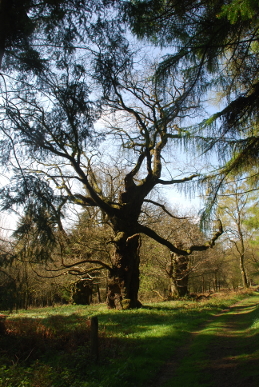
Monday – Croft – The stormy weather has given way to high pressure resulting in heavy frosts and now bright sunshine. Bird song is constant if a little thin, Chaffinches, Chiffchaffs, Song Thrushes and Robins all have sporadic bursts. A Wren sits on a bramble bough, its whole body quivering as a burst of song explodes out. A Mallard grunts before launching off of the fish pond with loud quacking. Trees are greening fast. Violets are little jewels set in the green-gold of Saxifrage and white Wood Anemones. Bluebells are starting to flower. Up a small side valley from the Fish Pool Valley. A Blackcap sings and Great Tits squeak urgently. A sign points up a steep, slippery slope to a small promontory overlooking the valley on which lies the grave of Captain Sir James Herbert Croft, 11th Baronet of the 1st Battalion, King’s Shropshire Light Infantry, and No.1 Commando, killed whilst training in Scotland with No.1 Commando on August 15th 1941. Daffodils and narcissus decorate the site. On up past a large sett, probably Badger and on to the Keeper’s Cottage track. The great old Oaks stand by the track as they have done for maybe 600 years or more. A Blackcap sings from the remains of a branch low on a fir on the edge of a plantation. A female with her chestnut crown hops through brambles. From Croft Ambrey, Willow Warblers can be heard singing on Leinthall Common.
Wednesday – Bodenham Lake – True April weather as showers pass through one after another. A Blue Tit slips into a narrow crack where a branch has broken off low down from a Lime tree, making an ideal nesting site. A Robin and a Blackcap sings, Carrion Crows caw. Canada Geese are making their usual cacophony. A few Mallard and Coot are on the edges of the lake, Tufted Duck on the boating bay and a single Cormorant, later joined by a second, in a tree, otherwise the water is empty. Blackcap, Garden Warbler, Chiffchaff and Willow Warbler all sing in the copse behind the hide. In the orchards, pears are now in full blossom. Many apples are still bare but both Gennet Moyle, a cider and jam apple, Irish Peach, a dessert variety and Golden Spire, a very old variety also known as Herefordshire Pomeroy or “Sugar Apple”, a dessert russet, are all in blossom.
Friday – Brentmoor Heath, Surrey – In West End, Surrey to visit family. I wander across the Guildford Road onto Brentmoor Heath. Through woodland on Sandpit Hill, where a hind slips away through the trees. A Great Spotted Woodpecker calls its harsh note. Further away a Green Woodpecker yaffles. The track comes to the top of a small hill, New England Hill. Below is open heathland of birch and gorse. Woodland of Scots Pine, birch and a few Oaks surrounds the areas of heathland. The sun has risen and is warming the damp, cool morning air. Blackcaps and Willow Warblers sing, Blue Tits chatter. Down to the back of New England House. Yellow Archangel is in flower beside the path. To the south, through the trees are the houses of Donkey Town, which was established in 1815 when the Lord of the Manor gave half acre plots of land to demobbed military personnel who wanted to build their own homes. The ground is soft, pale sand. The track meets the Brentmoor Road, now a track. This abuts Pirbright Ranges, Ministry of Defence land which rises to Greyspot and Dog Hills. More Great Spotted Woodpeckers call. Across to Cuckoo Hill where a Jay squawks and a Robin serenades. Down from Cuckoo Hill, which like all the hills here, is really a mere pimple and across the heath. Something is singing in a birch sapling. It looks like a Dunnock from this distance, but the song is wrong. I am so busy watching the bird I manage to fall down a rabbit hole, fortunately avoiding serious injury. Later, checking the song against a recording, I am sure the bird was a local speciality, a Dartford Warbler.
Saturday – West End – Across the recreation ground, formerly Streets Heath to the pond. A pair of Mallard graze and a Moorhen paddles away. Yesterday brought us intense downpours of hail but this morning is blue and bright again. Into Fairfield Lane. Two deer watch from neighbouring fields. The dominant songs are both just two notes – Great Tit and Chiffchaff. Onto a path when the lane and the expensive houses end. The path goes through a scrubby wood where a lot of Hazels have been coppiced in the past but not in recent years. Now, the path passes through the grounds of Brook Place, a house dating from 1656. Two lovely large greenhouses stand disused, one without glass. Alongside one are cold frames, glassless and rotting away. Heading back one notices the agricultural abandonment; broken fences, gates to nowhere, empty and overgrown barns. Much of this area was once a mixture of market gardening and nurseries, now most have gone. A strange squawk stops me and in a tree is a Ring-necked Parakeet. A more traditional call of a Green Woodpecker chimes with the songs of Blackcaps and Robins. Back at the recreation ground and cloud is building to threaten another day of squally showers.
St Georges Day, Monday – Mortimer Forest – It is cool and the sky is clouding over. As I get my stuff out the car, Maddy does something that I fail to see as she chases her ball and is now limping. We press on but I am unhappy with her movement. Chaffinches, Robins, Wood Pigeons, Song Thrush and tits are all singing or calling. I decide to abandon the walk at Peeler Pond as it seems silly to aggravate Maddy’s injury. Blackcap and Chiffchaff have joined the chorus.
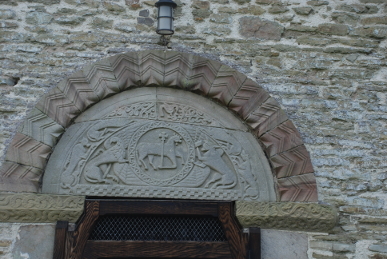
Pipe Aston – A hamlet just a couple of miles down the road from the forest. It has two mottes and a little Norman church. The parish is named variously Hesintune, Assiston, and Aston in the mediaeval period. The name, Pipe Aston, is recorded in the 1841 census indicating this was an important centre for clay pipe making in the 17th and 18th centuries. It seems that Pipe Aston is a “Thankful Village” in that it lost no residents in the Great War. The motte near the church had a bailey which lay where the road is now situated. It is thought the castle was built around 1138. Only the motte, called Aston Tump, now remains. The other motte may have been a siege-work dating from the Anarchy around 1140 or an earlier start to the castle which was abandoned. The church of St Giles is a delight but sadly locked. Above the entrance is a tympanum in superb condition. It shows an “Agnus Dei”, the Lamb of God, flanked by a Winged Bull and a Griffin. Above in scrolls of leaves is a bird pecking the head of a smaller one. Strange animals run around the sides of the main carving. It is the work of the Herefordshire School of the 12th century. Some windows are from a partial rebuilding in the 13th century, whilst others are wonderful Norman arches. Beside the road outside is Herefordshire CC Bridge No. 322, which is over a stream that used to feed the castle moat. The roadside verges are covered in buttery yellow Cowslips.
Sunday – Home – A sad day when I discover Ginger, the last of our original hens, has died. Although her egg production was a problem, they were extremely thin-shelled and this may be what killed her, one breaking inside, we decided to keep her as the “matriarch” of our little flock. The weather has been awful from the point of view of doing anything. Frequent showers and long outbursts of rain have dominated the week and today the rain is constant and there is a blustery, cold wind. Even weather as inclement as this does not deter Blackbirds, Song Thrushes and Chiffchaffs from singing. Of course, the land welcomes this watering after another dry winter and spring. Potatoes are now several inches high. Garlic and onions are both doing well. Broad beans are flowering profusely. Peas have sprouted and the first batch starting to climb the support netting. French beans have been sowed in pots in the greenhouse. I should start runner beans, sweet corn, courgettes and pumpkins but I think initially I will wait a few days to see how the weather develops, but change my mind and start sowing. We are, however, hoping for a considerable climatic improvement as the first camping trip of the season is only a few days away!
Monday – Humber – The first visit of the annual BTO Breeding Bird Survey. Starting at Steens Bridge, my route covers some fields then into Humber and out to the top of the hill above Stoke Prior. Then back along the lane for a short way towards Steens Bridge again. I have been planning to undertake this first survey for some days now but this is the first time it has actually stopped raining long enough. Although surveys can be carried out in the wet, the results are usually poor. In the event, the totals are not particularly good as there is still a blustery wind which keeps birds down in the hedges and bushes. The initial fields are sown with grain which is about a foot high or just grass. There is little in either, a few Blackbirds singing some way off, Dunnocks in the hedges, a pair of Pied Wagtails on the wires and Jackdaws, Carrion Crows and Wood Pigeons overhead. In Humber there are a few more small birds in the trees – Chiffchaffs, Chaffinches, Blue and Great Tits, more Jackdaws around the church and a Robin. Past the woodland cemetery to the farm near Stoke Prior. Again, few birds, indeed only one House Sparrow at the farm which is unusual. The second transect passes between a grain field and one yellow with oilseed rape. Both are devoid of anything other than the odd Common Pheasant. There are a few finches and tits in the roadside hedgerow but that is it. It starts to rain again as Maddy and I trudge back to Steens Bridge.